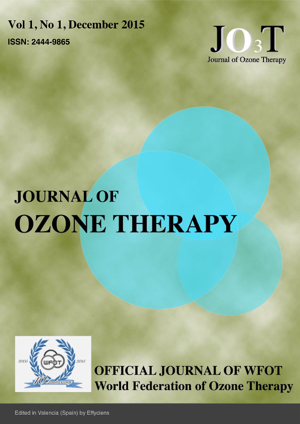Use of ozone therapy in chronic laminitis in a horse.
DOI :
https://doi.org/10.7203/jo3t.1.1.2015.12164Mots-clés :
ozone therapy, horse laminitis Résumé
Résumé
A ten year-old mare, 320 kg, was referred with signs of lameness and reluctance to ambulate. On clinical examination, animal showed signs of shifting weight lameness on the forelimbs, presence of palpable supracoronary depressions and severe signs of pain with hoof test pressure over the sole on right forelimb. Digital pulses and temperature of the hoof were thought to be within normal limits. On inspection it was possible to observe a short extension of the toe and solar prolapse with hoof capsule distortion. Radiologic measurements showed displacement of the distal phalanx (30o). The animal was diagnosed with Obel grade IV chronic laminitis on the right foot. Therapeutic protocol established included exclusively corrective trimming and intramuscular, peritendinous and intrarectal administration of oxygen/ozone therapy as anti-inflammatory therapy. Oxygen/ozone therapy sessions were performed twice a week, for a total of 20 sessions. Six months after original presentation, the mare demonstrated clinical improvement with an improved body condition and better ambulation. Radiologic evaluation showed a normal relationship between the dorsal hoof wall and the distal phalanx.
 Téléchargements
Téléchargements
 Références
Références
Baxter G. M. Acute laminitis. Vet Clin. North Am. Equine Pract. 1994;10(3):627-642.
Martins-Filho LP, Fagliari JJ, Moraes JRE, Sampaio RC, Oliveira JA, Lacerda-Neto JC. Estudo clínico e laboratorial da fase prodrômica da laminite equina induzida por sobrecarga de carboidrato. ARS Veterinária. 2007;23(1):32-39.
Moore JN, Allen D, Clark S. Pathophysiology of acute laminitis. Vet Clin North Am. Equine Pract. 1989;5(1):67-72.
Stashak T. Claudicação em Equinos segundo Adams. 5 ed. São Paulo: Roca; 2006.
Johnson PJ, Messer NT, Slight SH, Wiedmeyer C, Buff P, Ganjam VK. Endocrinopathic Laminitis in the Horse. Clinical Techniques in Equine Practice. 2004;3:45-56.
Johnson PJ, Kreeger JM, Keeler M, Granjam VK, Messer NT. Serum markers of lamellar basement membrane degradation and lamellar histopathological changes in horses affected with laminitis. Equine Veterinary Journal. 2000;32(6):462-468.
Moyer W, Schumacher J. Chronic Laminitis: Considerations for the Owner and Prevention of Misunderstandings. In: AMERICAN ASSOCIATION OF EQUINE PRACTITIONERS CONFERENCE, 46. 2000. Proceedings of the 2000 AAEP. San Antonio: AAEP; 2000.
Bocci V. Ozone: A new medical drug. 2nd ed. Heidelberg: Springer; 2006.
Buric J, Molino-Lova R. Ozone chemonucleolysis in non-contained lumbar disc herniations: a pilot study with 12 months follow-up. Acta Neurochir Suppl. 2005;92:93-97.
Ying WZ, Jiang CM, Wang ZM. Percutaneous treatment of lumbar disc herniation by oxygen-ozone injection: A clinical study of 322 case. Rivista Italiana di Ossigeno-Ozonoterapia. 2005;4(1):6-8.
Hunt RJ. Laminitis in the geriatric horse. Veterinary Clinics of North America. Equine Practice. 2002;18(3):439-452.
Oliveira-Jr J, Lages GV. Ozonioterapia em lombociatalgia. Revista Dor. 2012;13(3):261-270.
Dowling P. Myths and Truths About Controlling Pain and Inflammation in Horses. In: Agriculture and Rural Development [Internet], 2011. Available from: http://www1.agric.gov.ab.ca/$department/deptdocs.nsf/all/hrs3708
Iliakis E, Valadakis V, Vynios DH, Tisiganos CP, Agapitos E. Rationalization of the activity of medical ozone on intervertebral disc: a histological and biochemical study. Rivista di Neuroradiologia. 2001;14:23-30.
Bocci V, Luzzi F, Corrasdeschi F, Paulesu L, Di-Stefano A. Studies on the biological effects of ozone. III. An attempt to define conditions for optimal induction of cytokines. Lymphokine Cytokine Res. 1993;12(2):121-126.
Steppan JC, Boxley MK, Muto M, Balagurunathan K, Meaders T. Ozone mechanism of action for relieving pain associated with herniated intervertebral discs. J. Vasc. Interv. Radiol. 2009;20(2):16-17.
Friedman M, Madden MC, Samet JM, Koren HS. Effects of ozone exposure on lipid metabolism in human alveolar macrophages. Environ. Health Perspect. 1992;97:95-101.
Bulies JCE, Diaz OV, Rauder RS, Valdez YL, Garcia CL. Resultados terapeuticos en osteoartritis de la rodilla con infiltraciones de ozono. Rev. Cubana Invest. Biomed. 1997;16(2):124-132.
Bulies JCE. Una solucion para exposiciones oseas postraumáticas: asociacion de injerto de epiplon mayor com ozonoterapia. Rev. Cubana Invest. Biomed. 1996;15(2):1-9.
Bonetti M, Fontana A, Cotticelli B, Volta GD, Guindani M, Leonardi M. Intraforaminal O2-O3 versus Periradicular Steroidal Infiltrations in Lower Back Pain: Randomized Controlled Study. American Journal of Neuroradiology. 2005;26(5):996-1000.
O'Grady SE. Realignment of P3 – the basis for treating chronic laminitis. Equine Veterinary Education. 2006;18(4):214-218.
White N. Equine laminitis. In: The Waltham International Nutritional Science Symposium, 2005. Available from: https://www.vetmed.vt.edu/emc/welcome/bios/white/equine_laminitis.pdf
Redden RF. Shoeing the Laminitic Horse. In: AMERICAN ASSOCIATION OF EQUINE PRACTITIONERS CONFERENCE, 43. 1997. Proceedings of the 1997 AAEP. Phoenix: AAEP; 1997.
Parks AH. Chonic laminitis. In: Robinson NE. eds. Current therapy in equine medicine. St. Louis: Saunders; 2003.
O'Grady SE. Farriery for Chronic Laminitis. Veterinary Clinics of North America Equine Practice. 2010;26(2):407-423.
Belknap J. Treatment of the Chronic Laminitis Case. In: NORTH AMERICA VETERINARY CONFERENCE, 20. 2006. Proceedings of the 2006 NAVC. Orlando: NAVC; 2006.
Shallenberguer F. Principles and applications of Ozone therapy: A practical guideline for physicians. Kentucky: CreateSpace Independent Publishing Platform; 2011.
Téléchargements
Publiée
Comment citer
-
Résumé2400
-
PDF 683
-
HTML 2970
Numéro
Rubrique
Licence
Journal of Ozone Therapy applies the Creative Commons Attribution-NonCommercial 4.0 International License (CC BY NC 4.0) license to works we publish.
Under this license, authors retain ownership of the copyright for their content, but allow anyone to download, reuse, reprint, modify, distribute and/or copy the content as long as the original authors and source are cited. No permission is required from the authors or the publishers.
You may not use the material for commercial purposes.
Appropriate attribution can be provided by simply citing the original article, provide a link to the license, and indicate if changes were made.
You may do so in any reasonable manner, but not in any way that suggests the licensor endorses you or your use.




